|
|
|
|
#1 |
|
Members
Join Date: Oct 2009
Posts: 153
|
Hi Filiberto,
The number of extant ‘Crivelli» 15th century rugs is apparently a bit larger than what I thought initially. With two additional ones below: 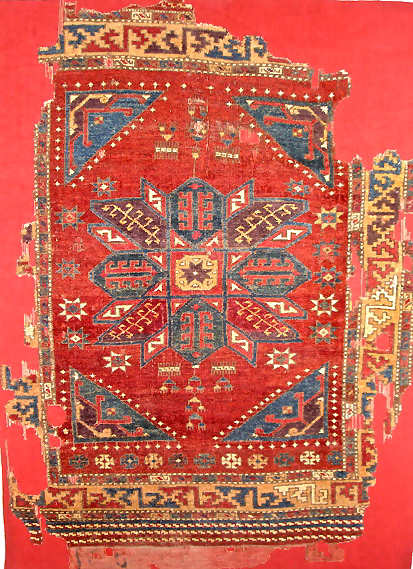  The whereabouts of the first one are unknown to me. The latter one is a large fragment, of which a computer reconstitution of the central medallion is shown here, which belongs to the Kirchheim collection (Orient Stars, page 275). These (painted or extant) Crivelli rugs show an interesting evolution of an animal motif from figurative to abstraction beyond recognition. The departure from naturalistic representation might have been caused, for example, by a stricter (local or temporary) enforcement of Islam’s ban of human and animal motifs. Another interesting point is the particular type of border of the first rug: A motif which has survived without change over a millenary, since it was already featured in the large carpet of the early fourteenth century miniature below (1330-1340, Il-khanid period, Tabriz school, "The bier of Iskander". Freer Gallery, Smithsonian ) and was still rather frequent in nineteenth century Caucasian rugs. 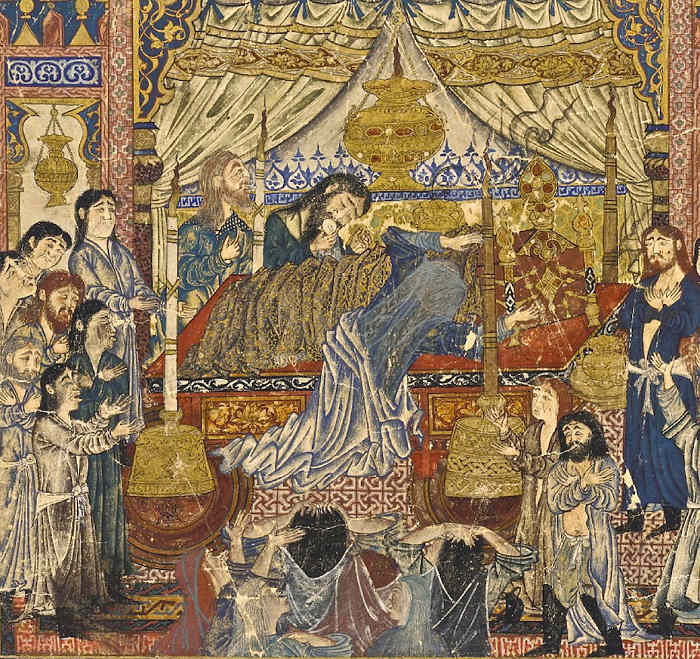 Best Pierre |
|
|

|
|
|
#2 |
|
Administrator
Join Date: May 2008
Location: Cyprus
Posts: 194
|
Hi Pierre,
The “Shahanama” border caught my attention years ago when I noticed the similarity with a Filippo Lippi’s fresco (Funeral of St. Stephen” ca.1460 Prato, Duomo). At the time I had prepared this composite image for a post that never materialized. The image shows the border in Lippi’s fresco in n.1, the Shahnama border in n.2, and two Shirvan borders in 3 and 4 (the latter a Marasali). 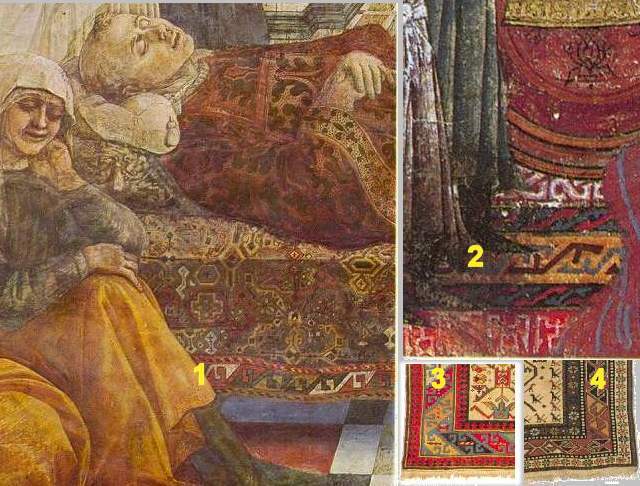 Facts to notice: - there are two flavors of the same border; the stepped one like in this  which I am glad you found  and the more linear one, like in the “Armenian Nachivan” above and the two painted examples and the more linear one, like in the “Armenian Nachivan” above and the two painted examples- besides the border, the rug in Lippi’s fresco is utterly mysterious.  Regards, Filiberto |
|
|

|
|
|
#3 |
|
Members
Join Date: Oct 2009
Posts: 153
|
Hi all,
There are indeed very few later medallions which could be considered evolutions from the Crivelli star. One could perhaps argue that the rare 16-sided star medallion below is such a heir, but it is more likely that it is derived from the much more frequent regular octagram, extensively used in rugs attributed to the Mamluk or in so-called star-Ushak carpets for example. 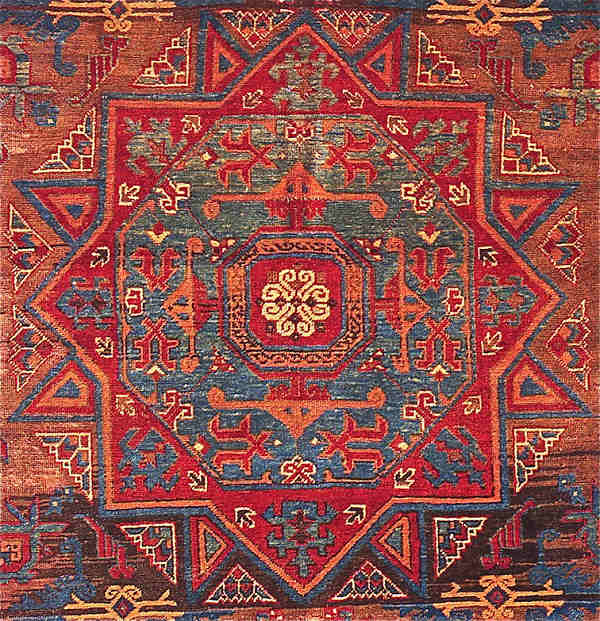 Source: B. Balpinar U. Hirsch, Teppiche, page 199. In the carpet below, the Crivelli design is barely recognizable and is demoted to the status of secondary motif. 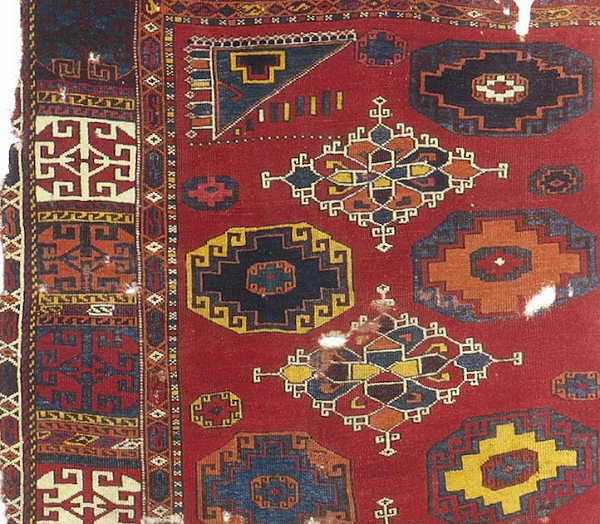 Source: H. Kirchheim, Orient Stars, page 294. Regards Pierre |
|
|

|
|
|
#4 |
|
Administrator
Join Date: May 2008
Posts: 163
|
Buon Giorno e Bonjour,
....and the stepped version lives on to this day. Or, at least, to the 1930's or so. It is always fascinating - to me - to find that nomadic tribespersons like those of the Sistan ( often considered somewhat isolated from the whole art history scene ) are so well read on the lesser points of the Old Masters:   Chuck Wagner |
|
|

|
|
|
#5 |
|
Administrator
Join Date: May 2008
Location: Cyprus
Posts: 194
|
Hi Chuck,
Isn’t amazing how borderless a rug border can be? How could it reach a relatively recent Baluch-type bag? Furthermore, that is not a motif commonly used in the region. As a matter of fact, I don’t recall any border like this used in the region. I’m going to delete your post (1) to avoid the pesky Balu-natic chatter which surely will follow your discovery - and I strongly suggest you to destroy the evidence. Regards, Filiberto (1) Just kidding, of course 
|
|
|

|
|
|
#6 |
|
Members
Join Date: Oct 2009
Posts: 153
|
Yes Chuck, indeed the universal success enjoyed by this border is amazing:
As proven by its chicken row the rug below was woven in Georgia USA ! Even though some eurocentric experts still attribute it to Spain, 15th century.  
|
|
|

|
|
|
#7 |
|
Members
Join Date: May 2008
Location: Massachusetts
Posts: 2
|
Hi Filiberto,
Ouch!! You really know how to hurt a guy. I was about to leap to the keyboard to tout the one more brick in the wall linking Baluch weavers to the 13th century Seljuk crowd, then I tripped over your deeply cutting "Balu-natic" remark. So, I had to cancel.  Pierre, Do you happen to know what is at the other end of that Spanish rug? More birds, or maybe an inscription, "Just us chickens?" Have you seen such birds on other Spanish carpets? The the curled tails may require some ornithological research. Rich Larkin |
|
|

|
|
|
#8 |
|
Administrator
Join Date: May 2008
Location: Cyprus
Posts: 194
|
Hi Rich,
No, the other end had the inscription: Fabricado en España con el diseño baluch That's why I had to crop the picture. 
|
|
|

|
|
|
#9 |
|
Members
Join Date: May 2008
Location: Massachusetts
Posts: 2
|
OK Filiberto,
    
|
|
|

|
 |
|
|